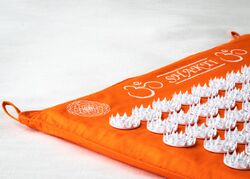Medicine:Acupressure mat
An acupressure mat, is a self-applied acupuncture device commonly made of a foam mattress covered in cotton sacking and embedded with hard plastic disks containing protruding spikes.[1]
History
Many believe that the acupressure mat originated from the bed of nails used by ancient gurus and yogis for healing and meditation. The bed of nails is made of an oblong piece of wood with thousands of nails embedded on it pointing upwards.
The bed of nails is a part of Indian mysticism hundreds of years ago, but today, it used to entertain people in circuses and sideshows to demonstrate the bravery, stamina, and invulnerability of the performer towards pain. On the other hand, science teachers use the bed of nails to demonstrate the principles of pressure.[2]
According to Tanya Zilberter, Ph.D., author of the book Reflexo-Therapy From Kutzenov Applicator to Shakti Mat, the idea regarding the bed of nails was introduced in Russia during the mid-19th century by Russian celebrity, Ivan Turgenev in his novel “Eve” wherein a patient in the story was asked to lie down on a bed of needles before a surgery. The procedure was done to keep the patient relaxed and his blood pressure at normal levels. Zilberter believed that acupuncture is the theory behind the procedure.
Zilberter found the person who created the first acupressure mat was Ivan Kuznetsov, a Russian music teacher who suffered from chronic pain. He had a severely impaired peripheral circulation and muscle spasm to the point that he could not move his limbs. Acupuncture was the only treatment that made him feel better, but the cost per session was too expensive for him, and only a few clinics in the country offer free acupuncture. He tried to learn how to perform acupuncture on himself, but he failed because he could not reach all the acupressure points on his back.
Kuznetsov then decided to pierce a sheet of tire rubber with thousands of office pins ¼ inch apart and lay on it to reach the acupressure points of his back. His idea worked and called his invention "Iplikator" and filed a patent in 1979. Since his invention, thousands of clinics in Russia tested the Iplikator and it was featured in a science magazine called Invention and Rationalization in 1981. The Department of Public Health in Russia approved the manufacturing and sale of the device with no trials.[3]
The modern acupressure mat was developed in Sweden, with origins in the yoga community. In August 2009 the Swedish manufacturer ShaktiMat organised a mass meeting of 3000 users in a park in Stockholm. They sat or laid down on their mats, which were arranged like sunbeams, and sang Mantras. The event resulted in an entry in the Guinness Book of Records.[4] Shortly afterwards, The New York Times reported on the new trend in Sweden.[5]
Usage
The modern acupressure mats have several thousand pointed spikes made from ABS plastic. These spikes resemble thick, blunt nails. The most popular ways to use acupressure mats is by lying on the mat, standing on it, or to roll it as a cushion to put under the neck when lying down. Depending on their needs, users can reduce the pressure at the contact points through wearing clothes.[6]
References
- ↑ Johannes, Laura (5 April 2011). "8,000 Spikes of Relaxation". Wall Street Journal. https://www.wsj.com/articles/SB10001424052748703712504576242782763737972. Retrieved 6 July 2013.
- ↑ How Stuff Works
- ↑ Tanya Zilberter (2010). Reflexo-therapy From Kuznetsov's Applicator to Shakti Mat: Forty year-long success story. CreateSpace Independent Publishing Platform. ISBN 978-1450597562.
- ↑ Guiness World Record ShaktiMat
- ↑ A Bed Where Comfort Is Not the Point The New York Times, 24. November 2009.
- ↑ ShaktiMat how to use


